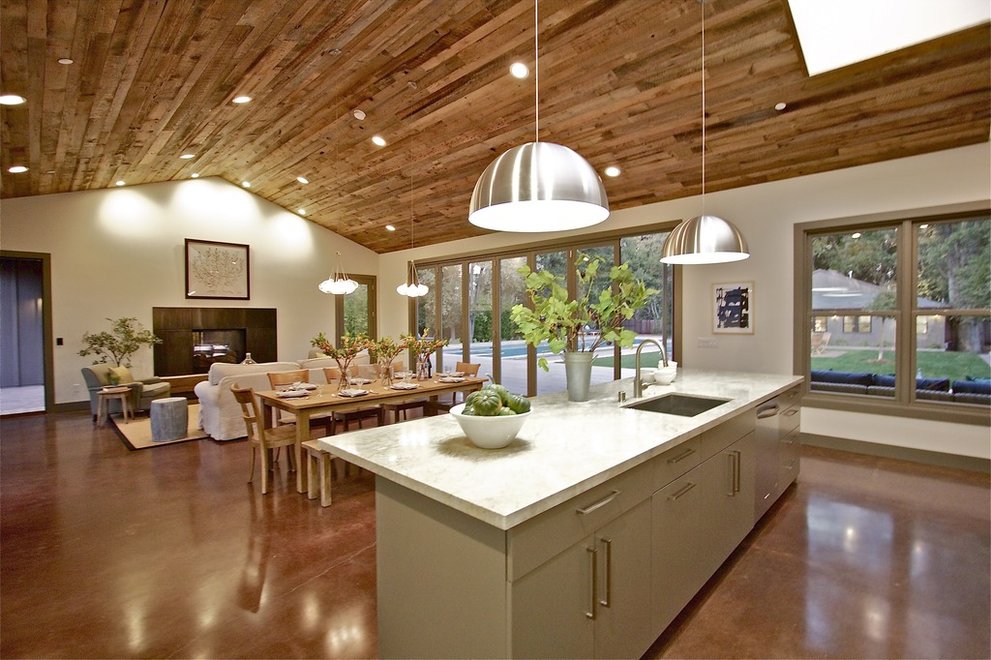Prefabricated roof trusses are a structural
engineering marvel and offer a number of advantages over stick-framed construction using conventional rafters. Roof trusses allow for wide spans as well as dramatic cathedral ceilings, like the great room ceiling in Plan 888-17, above,
and here. In addition, floor trusses can span up to 60 feet, opening up rooms and building layouts, and generally allowing for wider and more open interior spaces.
Task of a Truss
Trusses take advantage of the natural rigidity of triangular structures and use tricks of tension and compression to transfer the vertical load outward to the perimeter walls. Trusses are engineered to handle live loads, dead loads, and environmental loads like heavy snow and high wind. Trusses can be designed for nearly any roof configuration and for homes with cathedral ceilings. Their open web design allows for easy
installation of electrical and mechanical systems, making life easier for the builder. An example is this scissor truss, courtesy Timberlake Trussworks, LLC: "If the roof pitch is an 8/12 like this one pictured, the cathedral
pitch can be up to a 4/12." Visible trusses can accentuate a high ceiling, as shown here in Plan 140-149.
Potential Savings
They replace the rafters, ceiling joists and floor joists in traditionally built houses and instead use lighter dimensional lumber to achieve the same span and load bearing capacity at a lower cost. Roof and floor trusses are made with 25% less wood products than traditional stick framing! There is less job site waste as well and trusses can be installed faster with lower skilled workers than with conventional framing.
Methods and Materials
Trusses are made indoors with precision jigs and computer controlled saws and have very consistent quality. Most manufacturers have truss design software and consult with an engineering firm. Wood comes kiln dried and is usually straighter and of a higher grade than wood from the lumber yard. Roof trusses can be made for a wide range of building types including gable, hip and gambrel roofs. Floor truss systems have many of the same advantages as roof trusses.
Floor Trusses As Roof Trusses
Using a floor truss for a roof trust -- that is, instead of I-joists -- might work for flat roofed, Southwest style houses.
Floor trusses, like the example shown above (courtesy Abctruss co.) can clear-span with the same floor ratings much farther than any I-Joist product. The main disadvantages of trusses vs. floor joists is that the cost is higher and if there is a mistake or a change needs to be made during construction, there will be a delay. Talk to your architect or builder about whether floor trusses would be appropriate in your situation.
For more information about trusses, visit the Structural Building Components Association. Visit a helpful blog discussing the pros and cons of roof trusses vs. stick framing at Gould Design Inc.
and here. In addition, floor trusses can span up to 60 feet, opening up rooms and building layouts, and generally allowing for wider and more open interior spaces.
Task of a Truss
Trusses take advantage of the natural rigidity of triangular structures and use tricks of tension and compression to transfer the vertical load outward to the perimeter walls. Trusses are engineered to handle live loads, dead loads, and environmental loads like heavy snow and high wind. Trusses can be designed for nearly any roof configuration and for homes with cathedral ceilings. Their open web design allows for easy
installation of electrical and mechanical systems, making life easier for the builder. An example is this scissor truss, courtesy Timberlake Trussworks, LLC: "If the roof pitch is an 8/12 like this one pictured, the cathedral
pitch can be up to a 4/12." Visible trusses can accentuate a high ceiling, as shown here in Plan 140-149.
Potential Savings
They replace the rafters, ceiling joists and floor joists in traditionally built houses and instead use lighter dimensional lumber to achieve the same span and load bearing capacity at a lower cost. Roof and floor trusses are made with 25% less wood products than traditional stick framing! There is less job site waste as well and trusses can be installed faster with lower skilled workers than with conventional framing.
Methods and Materials
Trusses are made indoors with precision jigs and computer controlled saws and have very consistent quality. Most manufacturers have truss design software and consult with an engineering firm. Wood comes kiln dried and is usually straighter and of a higher grade than wood from the lumber yard. Roof trusses can be made for a wide range of building types including gable, hip and gambrel roofs. Floor truss systems have many of the same advantages as roof trusses.
Floor Trusses As Roof Trusses
Using a floor truss for a roof trust -- that is, instead of I-joists -- might work for flat roofed, Southwest style houses.
Floor trusses, like the example shown above (courtesy Abctruss co.) can clear-span with the same floor ratings much farther than any I-Joist product. The main disadvantages of trusses vs. floor joists is that the cost is higher and if there is a mistake or a change needs to be made during construction, there will be a delay. Talk to your architect or builder about whether floor trusses would be appropriate in your situation.
For more information about trusses, visit the Structural Building Components Association. Visit a helpful blog discussing the pros and cons of roof trusses vs. stick framing at Gould Design Inc.






